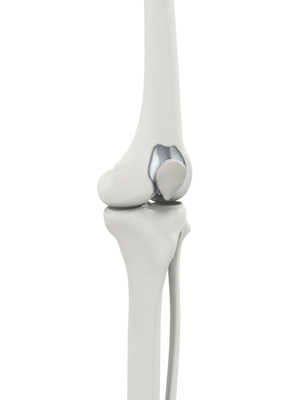Patellofemoral Knee Replacement

Patellofemoral Knee Replacement surgery may be recommended by your surgeon if you have osteoarthritis contained to the patellofemoral compartment (under the kneecap) and you have not obtained adequate relief with conservative treatment options.
Traditionally, a patient with only one compartment of knee arthritis would undergo a Total Knee Replacement surgery. Patellofemoral Knee Replacement is a minimally invasive surgical option that preserves the knee parts not damaged by arthritis as well as the stabilizing anterior and posterior cruciate ligaments, ACL and PCL. This less invasive bone and ligament preserving surgery is especially useful for younger, more active patients as the implant placed more closely mimics actual knee mechanics.
The smaller implants used with a partial knee replacement surgery are sometimes customized to the patient's anatomy based upon CT scans of the patient's knee. Patellofemoral Knee Arthroplasty surgery will not alter the ability of the patient to eventually move to a Total Knee Replacement in the future should that become necessary.
Partial Knee Replacement surgery is performed in an operating room under sterile conditions with the patient under spinal anesthesia with sedation or general anesthesia. It is usually performed on an outpatient basis as day surgery.
- The surgeon makes a small incision, about 3-4 inches long over the knee.
- The patellofemoral compartment is prepared for the artificial components by removing the damaged part of the patella and trochlea, the groove at the end of the femur.
- The new artificial components are fixed in place with the use of bone cement.
- The femoral component is made of polished metal and the patellar component looks like a plastic button which will glide smoothly in a groove located on the femoral component.
- With the new components in place, the knee is taken through a range of movements.
- Once the surgeon is satisfied with the results, the incision is closed and covered with a sterile dressing.
POST-OPERATIVE RECOVERY
Common Post-Operative guidelines include:
- You will be taken to the recovery room and monitored for any complications.
- You will be given pain medication to keep you comfortable at home.
- You will need someone to drive you home due to the drowsy effects of the anesthesia.
- Swelling is normal after knee surgery. Ice, compression, and elevation of the knee will be used to minimize swelling and pain.
- You will be given specific instructions regarding activity. Usually there are few activity restrictions.
- You will be referred to physical therapy for exercise and strengthening.
- Eating a healthy diet and not smoking will promote healing.
RISKS AND COMPLICATIONS
As with any major surgery there are potential risks involved. The decision to proceed with the surgery is made because the advantages of surgery outweigh the potential disadvantages.
Complications are rare after knee surgery, but unexpected events can follow any operation. Your surgeon feels that you should be aware of complications that may take place so that your decision to proceed with this operation is taken with all relevant information available to you.
Some complications related to Patellofemoral Knee Replacement surgery include:
Infection, deep vein thrombosis (DVT), ligament injury, injury to blood vessels or nerves, stiffness, scar tissue, component wear, dislocation or fracture.




